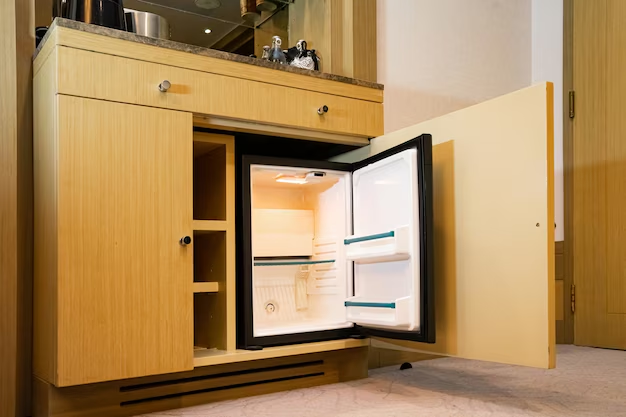Is 47 Degrees Cold Enough for Your Refrigerator to Keep Food Fresh?
Imagine opening your refrigerator, reaching for your favorite ice-cold snack, only to discover that it's not as cool as you expected. You glance at the digital display and see the number, 47 degrees Fahrenheit, staring back at you. A question might pop into your mind: is this cold enough for my refrigerator to ensure my food stays fresh and safe?
Let's delve into this common household conundrum, explore the standards of refrigerator temperatures, and answer whether 47 degrees Fahrenheit truly meets the mark.
🧊 The Ideal Refrigerator Temperature
Understanding Temperature Guidelines
When it comes to food preservation, temperature is crucial. The generally recommended refrigerator temperature is at or below 40 degrees Fahrenheit but above freezing at 32 degrees. This range ensures that food is kept fresh and the growth of harmful bacteria like E. coli or Salmonella is minimized. Anything above 40 degrees might allow these bacteria to thrive, posing a risk to food safety.
Why the Magic Number 40?
Forty degrees Fahrenheit acts as a threshold. It's cold enough to slow down spoilage and bacterial growth but warm enough to keep foods from freezing. The U.S. Food and Drug Administration suggests keeping your fridge settings at or below this temperature for optimal food safety.
🌡️ Is 47 Degrees Fahrenheit Suitable?
Examining 47 Degrees
Given the guideline of 40 degrees, 47 degrees seems on the higher side. At this temperature, perishable foods like dairy, meats, and some fruits may spoil faster. It's essential to understand how such changes impact your kitchen's overall food preservation.
Potential Risks
A refrigerator set to or functioning at 47 degrees could be unknowingly increasing food waste, which not only hits your pocket but also contributes to broader environmental impacts. Additionally, there's a health risk when consuming food that might have been kept in less-than-ideal conditions.
🔧 Maintaining the Right Refrigerator Temperature
Checking and Adjusting Your Fridge Settings
If your refrigerator's temperature is set to 47 degrees, consider these tips to adjust it accordingly:
Locate the Temperature Gauge: Most fridges have a simple dial or digital controls to set the temperature. Adjust the settings according to the manufacturer’s manual to ensure it stays at the recommended 35-38 degrees Fahrenheit, providing a buffer just in case.
Use a Thermometer: Place a reliable refrigerator thermometer in your fridge to check the internal temperature, ensuring it's accurate and consistent.
Routine Maintenance: Regularly clean and maintain your refrigerator to ensure it's running efficiently. This includes checking seals, cleaning coils, and ensuring proper airflow.
Practical Steps for Monitoring
Beyond initial adjustments, continued monitoring is vital. Consider setting reminders to check your fridge's internal temperature periodically. If there's a consistent discrepancy, it could indicate the need for professional maintenance or repair.
🍏 The Impact of Food Safety & Spoilage
Understanding Spoilage
Spoilage affects not only the taste but also the safety of your foods. Ingredients that spoil more rapidly at higher temperatures include:
- Dairy Products: Milk, cheese, and yogurt are particularly sensitive.
- Meats: Both raw and cooked meats can harbor bacteria if not stored correctly.
- Fruits and Vegetables: Some fruits, while potentially less hazardous, begin to break down faster.
Health Implications
Consuming food that is compromised due to improper temperature can lead to foodborne illnesses. While initial symptoms might be mild, they can escalate, particularly in vulnerable populations like children or the elderly.
⚡️ Energy & Environmental Considerations
Balancing Temperature and Energy Efficiency
Running a refrigerator at a lower temperature might slightly increase energy use, but this is a worthwhile trade-off for ensuring food safety. Conversely, operating at 47 degrees might save a bit on electricity bills short-term but potentially lead to more frequent grocery shopping due to spoilage.
Environmental Impact
Maintaining food quality helps in reducing food waste, which is a significant contributor to environmental degradation. Keeping your fridge at optimal temperatures aligns with eco-friendly practices by conserving resources used in food production and minimizing waste.
📋 Quick Summary & Tips for Optimal Fridge Use
To help you keep your refrigerator at its best, here’s a quick reference guide:
- Ideal Temperature: Keep your fridge between 35-38°F (1.7-3.3°C) for optimal freshness.
- Regular Checks: Use a thermometer to ensure accurate readings.
- Maintenance: Clean and maintain your fridge regularly, checking door seals and cleaning coils.
- Health Precautions: Pay attention to the state of dairy and meat products, arranging them so they receive the coolest air.
- Eco-Friendly Practices: Adjusting settings to improve energy efficiency while reducing food waste.
By following these practical tips, you can help ensure your fridge runs efficiently, keeps your food safe, and minimizes your environmental footprint.
Wrapping It Up
Understanding the importance of maintaining your refrigerator at the right temperature can greatly affect not only your food's longevity and safety but your health and impact on nature. While 47 degrees might seem like a minor deviation, it is crucial to adjust it down to safeguard your health and prevent food spoilage.
As always, keeping an eye on your fridge’s performance through regular checks and maintenance will keep your kitchen running smoothly and ensure those midnight snacks are just the right temperature every time.
